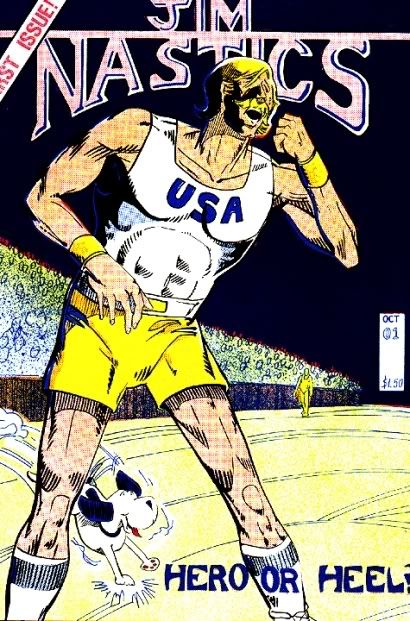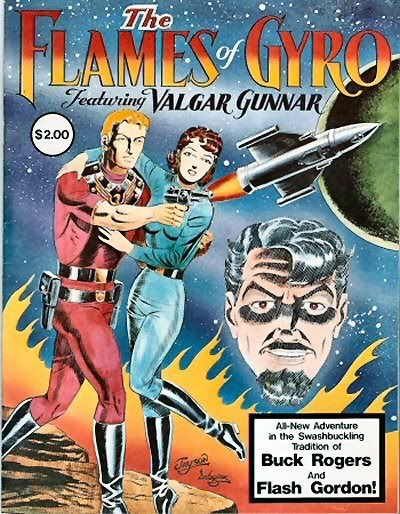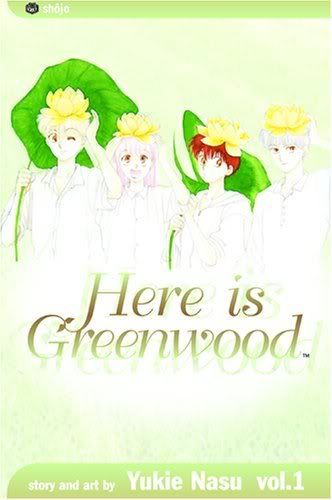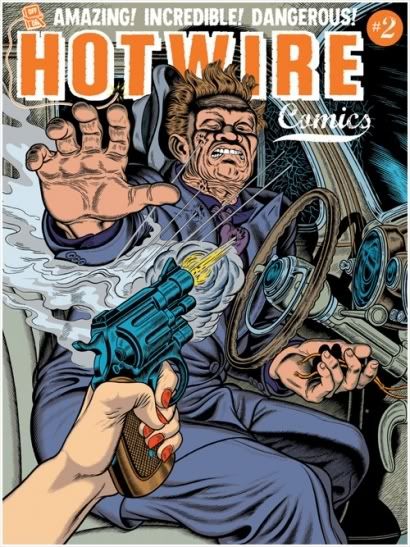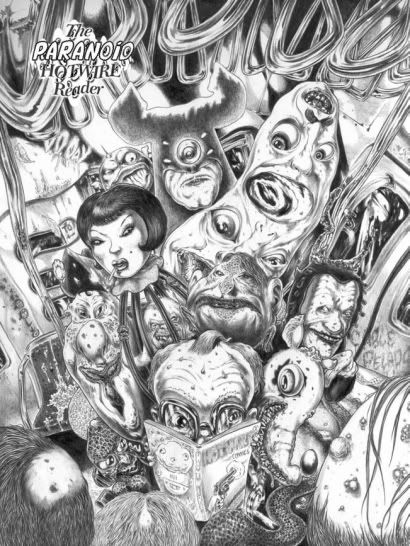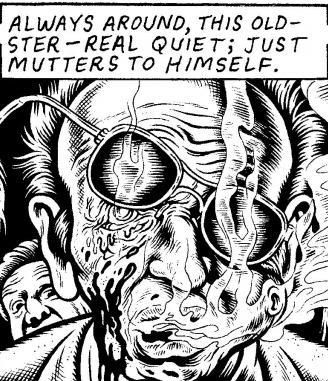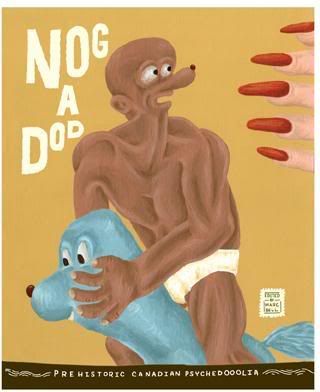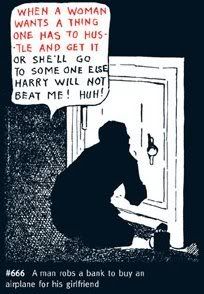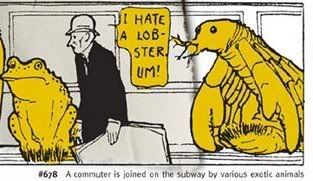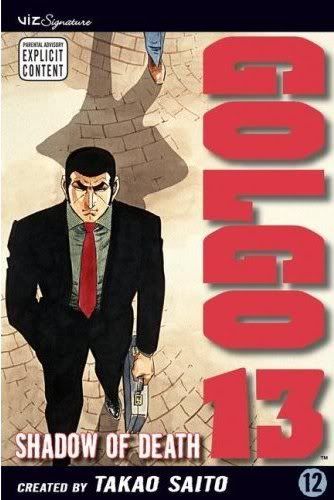King City Vol. 1By now, I suspect most of you recognize writer/artist
Brandon Graham, he of the recent Oni comic
Multiple Warheads. This is his
other prominent release from 2007, a full-scale 192-page digest-format original, published by Tokyopop at the $9.99 price point. It's the first of at least two volumes.
The book has a bit of history behind it; initially announced in 2006 as one of several Tokyopop titles marked for exclusive release through the publisher's website -- you might recall enough controversy breaking out online that Minetaro Mochizuki's popular-among-commentators
Dragon Head got successfully moved back into ready bookstore distribution --
King City was eventually made available to retailers through Diamond in 2007, and has just now appeared in chain bookstores through more typical channels for the start of 2008. As a result of this slow rollout, some have long ago read the book (indeed,
Ivan Brandon recently named it the best comic of 2007) (
EDIT: so did
Abhay Khosla), but many more wound up with Multiple Warheads as their first exposure to Graham's work, myself included.

But neither of those were anyone's first chance to get acquainted anyway. As it often goes, Graham is one of those 'new' cartoonists who've actually been publishing work for well over a decade. He's created pamphlet-format miniseries for such early OEL manga specialists as Antarctic Press (
October ¥en) and Radio Comix (
Universe So Big). He's contributed short works to the venerable
Heavy Metal. He's been part of the famed
Meathaus group of visual artists (see also: Farel Dalrymple, James Jean, Tomer Hanuka, Dash Shaw, Becky Cloonan) since its beginning. He's had one collection of stories released by Alternative Comics (
Escalator), and two albums of smut released by NBM (
Perverts of the Unknown and
Pillow Fight).
And few of those projects are solitary - the cast of Multiple Warheads first appeared in a porn short, then showed up in the title story of Escalator, before finally moving on to their own series. Escalator also sported a returning character from October ¥en, and a story set in King City, which was intended to launch a six-issue miniseries. It didn't, and the content of that story is
not the content of this book, although several of
this book's main characters can nevertheless be glimpsed walking the streets of that earlier collection, not yet selected for primacy.
As such, it's perhaps easier to view Graham's work as more a flowing stream than a set of islands. Most of his works share similar enough approaches -- young people walking comfortably yet hesitantly through a fantastic world, hanging around with friends and fussing over current/prospective/former romantic partners, with a softly detailed sci-fi plot going on at the margins -- that newer projects seem like redefinitions of older ones.
In this way, a project from 1996 like October ¥en, which bisected plot threads of a robot on a mission into a pocket dimension and a 'furry'-type alien reluctantly going to a party, isn't all that different from 2007's Multiple Warheads, although the interactions between young people and the sci-fi adventure stuff have been integrated, with the latter acting mainly to compliment the former with allegorical weight or novel urban decoration.
If anything, Graham's work is even
more a chronicle of day-by-day youth living then something like
Powr Mastrs, in that his comparatively straightforward visual and narrative style keeps the focus on narrated thoughts and supple human forms. If the likes of C.F. and Brian Chippendale operate as a redefinition of 'underground' fantasy comics, Graham blends his own considerable underground influence with the popular clarity of various manga, resulting in a less alien display.
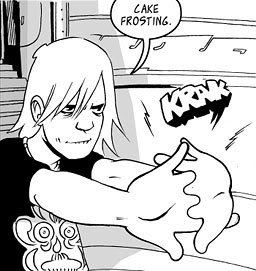
And while King City may not be the newest of Graham's projects, it
is the most sophisticated in terms of construction. Graham notes in an Afterword that this first volume alone is nearly double the size of the longest comic he's ever done, but he shows little hesitancy in execution - indeed, King City may be the most successful adoption of popular shōnen (or seinen-on-the-edge-of-shōnen) manga pacing by a Western artist I've yet come across.
The chapter-by-chapter give-and-take of many popular manga often strike me as a product of Japan's unique serialization scheme, one that Western artists don't have access to; as a result, some English-language 'manga'-style projects seem lumpy or start-and-stop in comparison. This is not a problem for Graham, whose work flows as quickly and smoothly as anything read from the opposite direction. It helps that Graham has a firm grasp of page balance (and inter-page balance), carefully playing light against dark and crowded panels against wide views. His sense of page design is quite good too:
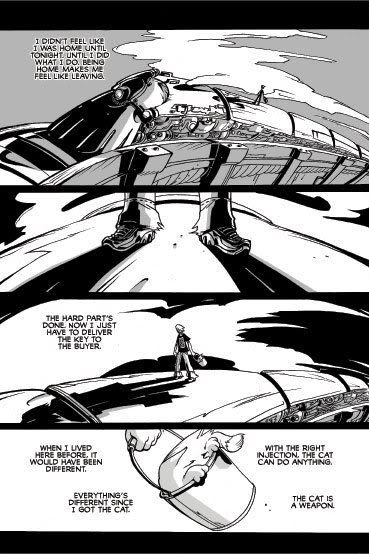
Notice how the bridge in panel #1 'transforms' into legs in panel #2, the shadows of those legs drifting into the sky of panel #3, where the stylized direction of the train mimics the tilt of the bucket in panel #4. In this way, the reader's eyes are guided smoothly down the page, with the out-in-out-in viewpoints of the panels first reinforcing the strength of the lead character, feet firmly planted on the train like iron girders, then emphasizing the speed of his travel what with whooshing clouds and a bent trajectory and the rocking bucket.
The book is full of good visual concepts of that sort, which the expanded length of the digest format allows for - there's perhaps less lived-in environmental clutter than Graham's other works (not to mention less 'underground' flourish), which I think compliments the work's status as a 'manga' type of comic one would expect from Tokyopop. This isn't to say that Graham's in-panel work is any less diverse with influence -- there's a great little bit where two characters confront a street gang called the Owls, perched on streetlights and ledges like in Taiyō Matsumoto's
Tekkonkinkreet but clad and silhouetted in a very Mike Mignola style, and I wouldn't have expected such a mix to work so well -- but its mechanics are more distinctly inclined toward the fast, light reading I associate with a lot of manga.
But now I'll cop to being more taken with the visual execution of the book than anything else. The story concerns a young King City spy and lockpick named Joe, who's just gotten back into town from completing his training as a Cat Master. As everyone knows, cats can adopt different attributes -- drill, parachute, fire-breather -- when injected with Cat Juice, and a skilled Cat Master can thereby accomplish a lot for himself.
It's a concept somewhat reminiscent of Paul Pope's
THB (speaking of East-West fusion), although Graham is more inclined to play up the cartoonish, elastic possibilities inherent, with the cat in question often acting like a mascot or sidekick, while Joe wanders around with his pal Pete (a good-natured lump in a Dumb Donald cap, involved in shady business) and pines a lot after his lost love Anna. Dirty work is going down, and the plot simmers while characters shoot the breeze, encounter funny and imaginative technologies, and indulge in wordplay, only for action to crop up at the end.
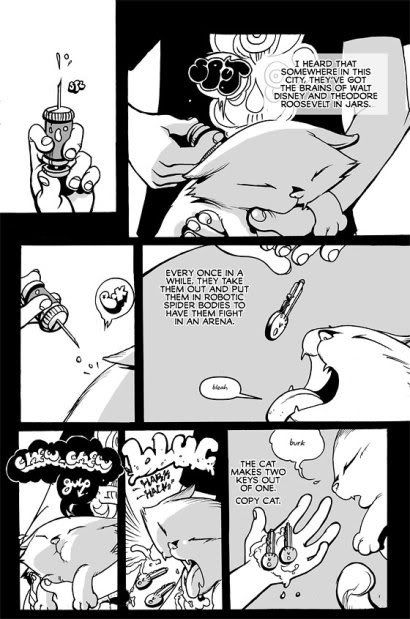
This is often a very
boyish comic, infatuated with gadgets, delighted by cool fights, pining over the enigma of girls, and mixing protectionist impulses with nervous arousal. That's not inappropriate, given the kind of manga it looks and feels like, but I did find myself wearing out as character development and plot strands continually led to nowhere unexpected. Graham is talented at crafting intimate conversations or scenes of friends hanging out, but the 'big' moments he inserts are comparatively obvious and rather banal (guilty blood money
scattering in the rain!), and the plot's big threats at volume's end are mostly dull (being a bad organization with eyes throughout the world and a Lovecraftian thingy), if enlivened a bit by Graham's enthusiastic grip on action and movement.
And considering the amount of space given over to romantic longing, the female characters are shallowly developed. There's a sexy & mysterious yet dangerous woman who acts sexy & mysterious yet dangerous, with plenty of breast and butt emphasis in the panels. There's a 'furry' alien girl who exists solely to get Pete's
moé flowing, her possibly awful fate positioned here as nothing more than an emotional beat upon which to define the male character - hell, she doesn't even get to speak
English, translated or otherwise, but she
does get to balance strawberries on her nose like a sexy seal of some sort (was it Miyazaki that remarked that
moé is like wanting a girl for a pet?). Anna gets the most definition, in that she's apparently a 'main' character, but her arty quirks and frowny worries don't amount to much, particularly when her boyfriend gets a detailed zombie-fighting body horror world-building subplot all his own.
But this
is only volume 1, and there's plenty of time to work with these characters. Graham's visual skill is formidable, and his ideas are good; he's great with places and fleeting dialogues, and he knows how to pace a comic. These are considerable strengths, and I doubt he's near the end of his growth. In a way, it's good that I have the later Multiple Warheads in front of me, because I know Graham can pull a short story together into a pleasing, breezy whole. He's not yet done with this longest work, so there's reason for confidence.
